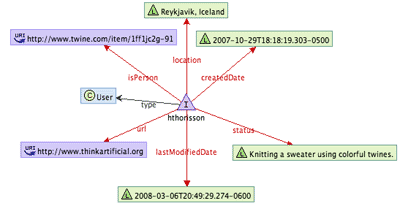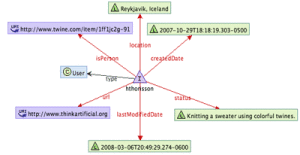These are my notes from the third paper 'The API as Curator' by Aaron Straup Cope in the Theoretical Frameworks session chaired by Darren Peacock at Museums and the Web 2008. The slides for The API as Curator are online.
I've also included below some further notes on why, how, whether museums should hire programmers, as this was a big meme at the conference and Aaron's paper made a compelling case for geeks in art, arty geeks and geeky artists.
You might have noticed it's taken me a while to catch up on some of my notes from this conference, and the longer I leave it the harder it gets. As always, any mistakes are mine, any comments corrections are welcome, and the comments in [square brackets] below are mine.
The other session papers were Object-centred democracies: contradictions, challenges and opportunities by Fiona Cameron and Who has the responsibility for saying what we see? mashing up Museum and Visitor voices, on-site and online by Peter Samis; all the conference papers and notes I've blogged have been tagged with 'MW2008'.
Aaron Cope: The API as curator.
The paper started with some quotes as 'mood music' for the paper.
Institutions are opening up, giving back to the communitiy and watching what people build.
It's about (computer stuff as) plumbing, about making plumbing not scary. If you're talking about the web, sooner or later you're going to need to talk about computer programming.
Programmers need to be more than just an accessory – they should be in-house and full-time and a priority. It boils down to money. You don't all need to be computer scientists, but it should be part of it so that you can build things.
Experts and consumers – there's a long tradition of collaboration in the art community, for example printmaking. Printers know about all the minutiae (the technical details) but/so the artists don't have to.
Teach computer stuff/programming so that people in the arts world are not simply consumers.
Threadless (the t-shirt site) as an example. Anyone can submit a design, they're voted on in forum, then the top designs are printed. It makes lots of money. It's printmaking by any other name. Is it art?
"Synthetic performances" Joseph Beuys in Second Life…
It's nice not to be beholden to nerds… [I guess a lot of people think that about their IT department. Poor us. We all come in peace!]
Pure programming and the "acid bath of the internet".
Interestingness on Flickr – a programmer works on it, but it's not a product – (it's an expression of their ideas). Programming is not a disposable thing, it's not as simple as a toaster. But is it art? [Yes! well, it can be sometimes, if a language spoken well and a concept executed elegantly can be art.]
API and Artspeak – Aaron's example (a bit on slide 15 and some general mappy goodness).
Build on top of APIs. Open up new ways to explore collection. Let users map their path around your museum to see the objects they want to see.
Their experience at Flickr is that people will build those things (if you make it possible). [Yay! So let's make it possible.]
There's always space for collaboration.
APIs as the nubby bits on Lego. [Lego is the metaphor of the conference!]
Flickr Places – gazetteer browsing.
[Good image on slide 22]: interpretation vs intent, awesome (x) vs time (y). You need programmers on staff, you need to pay them [please], you don't want them to be transient if you want to increase smoothness of graph between steps of awesomeness. Go for the smallest possible release cycles. Small steps towards awesome.
Questions for the Theoretical Frameworks session
Qu from the Science Museum Minnesota: how to hire programmers in museums – how to attract them? when salaries are crap.
Aaron – teach it in schools and go to computer science departments. People do stuff for more than just money.
Qu on archiving UGC and other stuff generated in these web 2.0 projects… Peter Samis – WordPress archives things. [So just use the tools that already exist]
Aaron – build it and they will come. Also, redefine programming.
There's a good summary of this session by Nate at MW2008 – Theoretical Frameworks.
And here's a tragically excited dump from my mind written at the time: "Yes to all that! Now how do we fund it, and convince funders that big top-down projects are less likely to work than incremental and iterative builds? Further, what if programmers and curators and educators had time to explore, collaborate, push each other in a creative space? If you look at the total spend on agencies and external contractors, it must be possible to make a case for funding in-house programmers – but silos of project-based funding make it difficult to consolidate those costs, at least in the UK."
Continuing the discussion about the benefits of an in-house developer team, post-Museums and the Web, Bryan Kennedy wrote a guest post on Museum 2.0 about Museums and the Web in Montreal that touched on the issue:
More museums should be building these programming skills in internal teams that grow expertise from project to project. Far too many museums small and large rely on outside companies for almost all of their technical development on the web. By and large the most innovation at Museums and the Web came from teams of people who have built expertise into the core operations of their institution.
I fundamentally believe that at least in the museum world there isn't much danger of the technology folks unseating the curators of the world from their positions of power. I'm more interested in building skilled teams within museums so that the intelligent content people aren't beholden to external media companies but rather their internal programmers who feel like they are part of the team and understand the overall mission of the museum as well as how to pull UTF-8 data out of a MySQL database.
I left the following comment at the time, and I'm being lazy* and pasting here to save re-writing my thoughts:
Good round-up! The point about having permanent in-house developers is really important and I was glad to see it discussed so much at MW2008.
It's particularly on my mind at the moment because yesterday I gave a presentation (on publishing from collections databases and the possibilities of repositories or feeds of data) to a group mostly comprised of collections managers, and I was asked afterwards if this public accessibility meant "the death of the curator". I've gathered the impression that some curators think IT projects impose their grand visions of the new world, plunder their data, and leave the curators feeling slightly shell-shocked and unloved.
One way to engage with curatorial teams (and educators and marketers and whoever) and work around these fears and valuable critiques is to have permanent programmers on staff who demonstrably value and respect museum expertise and collections just as much as curators, and who are willing to respond to the concerns raised during digital projects.
There's a really good discussion in the comments on Bryan's post. I'm sure this is only a sample of the discussion, but it's a bit difficult to track down across the blogosphere/twitterverse/whatever and I want to get this posted some time this century.
* But good programmers are lazy, right?

